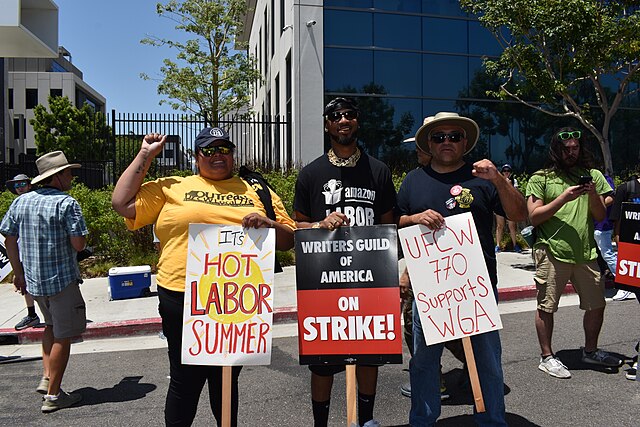
By
Before “Hot Strike Summer,” there was the “Union Boom.” Workers at Amazon, Trader Joe’s, REI, Starbucks, and other corporations banded with their fellow workers to improve working conditions.
This drive, led by the workers, is shaking up workplaces and industries nationwide — a welcomed reversal to the decades-long decline of unionization rates for advocates of worker’s rights.
Union membership rates peaked at 35% in the 1950s, a report from the U.S. Department of Treasury found, and have steadily declined since the 1970s.
And membership is still declining, with a recent dip from 10.3% in 2021 to 10.1% in 2022. Along with it, the number of workers represented by unions dipped from 11.6% to 11.3% at the same time, according to the Economic Policy Institute.
Unionization is most common among public-sector workers, protective service occupations, education, training, library occupations, and transportation and utilities industries.
And Black folks have higher rates of unionization or union membership than any other racial and ethnic group. That’s not without cause or history.
Unions provide better working conditions with higher wages, good benefits, and less discriminatory retaliation from employers.
But those who oppose unions, like the Heritage Foundation, argue that they cause layoffs, obstruct market competition, and drive up prices.
There’s also the case against unions from “right-to-work” states, which allow workers to choose whether to join a labor union and make union dues optional. Critics of this law say it favors corporations and worsens conditions for workers.
“The union movement is the equalizer,” Fred Redmond, secretary-treasurer of the American Federation of Labor and Congress of Industrial Organizations, says. The AFL-CIO represents 12.5 million workers internationally.
“It’s the equalizer to workplace fairness, fair wages, and retirement security. Because when workers stand up together and bargain collectively, that’s how they make achievements in the workplace.”
FRED REDMOND
Union participation creates conditions that can move the Black community closer to parity for the ever-growing racial wealth gap.
“The legacy of not having access to wealth-building opportunities that Black families have faced over decades, those things are labor market independent,” says Kyle K. Moore, economist for the Economic Policy Institute’s program on race, ethnicity, and the economy.
“But there is a component of the racial wealth gap that comes from the labor market, and being in a union allows [people] to mitigate that.”
Moving On Up: From Poverty to the Middle-Class
Black people are not new to unions; they are true to unions — and have been since the early 1900s.
The Black male porters working for the Pullman Company founded the first all-Black labor union, the Brotherhood of Sleeping Car Porters, in 1925. At that time, 20,224 Black Americans were working as Pullman Porters.
Their pay was low, and according to the Chicago History Museum, workers would need to work “at least 400 hours each month to earn their full monthly pay.” They faced long hours, constant racism at work, and threats of firing for unionizing.
After 12 years of negotiating, the BSCP collectively bargained a contract with the Pullman Company under union president A. Philip Randolph. This contract gave workers at the company increased wages and a maximum of 240 working hours per month.
The National A. Philip Randolph Pullman Porter Museum notes that the union made the Pullman Porter job one of “economic stability,” holding “high social prestige in the African-American community.”
The BSCP merged with the Brotherhood of Railway Clerks in 1978. But the labor movement continues to play the same vital role for the Black community.
Union households have at least one person covered by a union contract and have more wealth than their non-union counterparts. Within Black union households, the median wealth has been around $101,000 compared to $29,000 for non-union households.
“The fact of the matter is that the Black middle class was essentially built by the labor movement,” Redmond says. “What we see is that people are fed up, including Black workers, by not being able to share in the wealth they help create on these jobs every day.”
Sustaining the ‘Union Boom’
The unionization rate is far from what it used to be because of obstacles from companies and politicians.
Nevertheless, union advocates persist and recommend steps to take as a nation to increase the number of unions and unionized workers.
The National Labor Relations Board, an independent federal agency created to enforce the National Labor Relations Act, recently announced a new framework for union representation proceedings.
Under the framework, employers must promptly recognize and bargain with the union or file a petition for an election. However, if the employer commits unfair labor practices, the election petition will be dismissed, and the NLRB will order the employer to recognize and bargain with the union.
From the perspective of Moore and Redmond, this recent move from the NLRB is a step in the right direction, but Congress needs to act further.
Both EPI and the AFL-CIO believe in the power of the bipartisan Protecting the Right to Organize (PRO) Act, which would protect workers’ right to unionize and bargain for better pay and benefits. The Public Service Freedom to Negotiate Act also provides public employees collective bargaining rights and procedures.
When employers and the government make it difficult for workers to unionize, Moore says it goes against the democratic representation that was a pillar in the nation’s founding.
“If we live in a democracy, then it should be up to the folks who live there to decide how they want to be represented and if they want to get to the table and negotiate,” he says. “And they should be able to do that without being impeded in their effort to even get to the table in the first place.”


